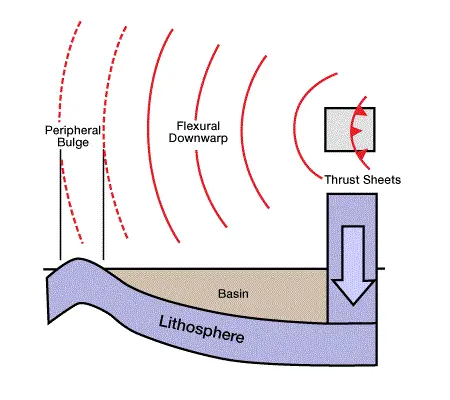Mechanical and Thermal Loads
Once we have a layered earth structure, the second factor in the formation or modification of basins are tectonic stresses, or loads, caused by mechanical and/or thermal factors induced by dynamic interactions between tectonic plates. Because plate interactions also control lithospheric rheology and initial configurations, we can relate types of loading and estimates of responses to plate tectonic settings.
Mechanical loads, which can be positive or negative, are masses that are physically emplaced or removed at the base of (sublithospheric), within (lithospheric) or on top (supralithospheric) of the lithosphere. All basins are modified by supralithospheric loads such as erosion, deposition, and addition or subtraction of water due to eustatic variations or localized transgressions and regressions. These loads cause regional deflection and amplify subsidence caused by tectonic, thermal or mechanical loads. For example, the maximum deflection caused by sediment filling a topographic basin is approximately 2.4 times the original water depth of the basin.
Some mechanical loads are due to tectonics. Tectonic supralithospheric loads are masses such as thrust sheets and block uplifts that are tectonically placed at the upper surface of the lithosphere (Figure 1, Flexural response of the lithosphere to an emplaced lithospheric load, such as thrust sheet.

A foreland basin forms adjacent to the thrust sheet load. Beyond the foreland basin, a smaller amplitude flexural upwarp, or peripheral bulge, may form).
Supra-lithospheric loading causes flexural downwarp adjacent to the load, with a smaller flexural upwarp, or peripheral bulge, beyond the depression. The magnitude and dimension of the deflection depend on the magnitude, dimension and position of the load and the lithospheric rheology.
Tectonic subcrustal or sublithospheric loads are density variations that have been mechanically placed beneath the crust or lithosphere by subduction. For example, cooler and denser lithosphere subducted at relatively shallow depths acts as a load on the overlying lithosphere by displacing hotter and lighter asthenosphere. Shallow subduction can cause regional subsidence in cratonic or foreland tectonic positions. The magnitude and dimension of subsidence depend on the density difference between the subducted plate and displaced asthenosphere and on the dimension of the shallow portion of the subducted plate.
Thermal loads are changes in weight distribution due to density changes within or beneath the lithosphere. Density changes can be caused by heating associated with lithospheric extension, the thermal decay of a heated mass, lateral cooling toward adjacent heat sinks, or cooling of overlying lithosphere by a shallow, subducted oceanic plate. Heating lithospheric material decreases its density and increases its buoyancy, while cooling lithospheric material increases its density and decreases its buoyancy.
Lithospheric extension changes the weight distribution of crust, lithospheric mantle and asthenosphere and leads to either initial subsidence or uplift. Extension may be a passive response to plate rifting, to transtension associated with strike-slip faulting, or to active asthenospheric diapirism. Thermal events are commonly associated with extension because rising asthenospheric material replaces the lithospheric mass reduced locally by stretching and thinning. Continental extension and thinning is the primary mechanism behind the formation of rifts and passive margins.
Isostatic compensation caused by the thermal decay of heated lithosphere can result in regional subsidence. As the lithosphere cools, isotherms deepen, and the lithosphere thickens and becomes less buoyant. Subsidence caused by thermal decay is associated with rifts, passive margins and some cratonic basins. The magnitude of regional subsidence caused by thermal decay depends on the magnitude of thermally induced density variations. The magnitudes and rates of subsidence decrease exponentially because thermal decay occurs primarily through conductance.
Another cause of subsidence is the isostatic response to subcrustal cooling caused by shallow subduction. Lithosphere subducted at shallow depths may act as a heat sink, cooling the hotter mantle of the overlying lithosphere. The magnitude of the resulting regional subsidence depends on the duration of shallow subduction and on the temperature difference between the subducted and surrounding lithosphere.
The loading history is the primary control on basin evolution because the dimension, magnitude and rate of loading control the rate and magnitude of subsidence and heat flow, and because the loading history modifies the mechanical and thermal properties of the lithosphere.
A loading event may incorporate both mechanical and thermal forces during the evolution of a basin. For example, initial subsidence or uplift of a rift may be caused by lithospheric thinning due to thermal doming and/or mechanical extension. Subsequent subsidence may be caused by lithospheric thermal contraction and loading due to sedimentary fill. Or, shallow subduction might cause regional subsidence due to mechanical loading by replacing lighter, hotter asthenosphere with denser, cooler lithosphere.
 Petro Shine The Place for Oil and Gas Professionals.
Petro Shine The Place for Oil and Gas Professionals.



